
Wine Culture and Information since 2002 - Volume 22
 Wine Culture and Information since 2002 - Volume 22 |
|
Aromatic Sweet WinesSweet wines represent an extraordinary sensorial experience for any taster, a world of complex and charming aromas made of endless surprises, and when aromatic grapes are involved, there is also magic |
|
Tasting sweet wines - the ones produced with dried grapes, naturally dried in the vine or exposed to air after harvesting - is like traveling in the past, in that magic world capable of impressing with rich and charming aromas and tastes. A journey in the past because, in ancient Greek and Roman times, wines were mainly sweet - dry wines will be produced in later times - a magic world because aromas and tastes these wines can develop do not compare to any other wine style. Even in later times, sweet wines were considered rare and valuable, a real status symbol for those times and that were usually found in the tables of rich and noble people also for impressing their guests. just like any other wine, progresses and development made by wine making technologies have introduced changes - sometimes even drastically - in the production of sweet wines, frequently adapting them to the taste of our times, although keeping intact their charm, value and prestige. Being sweet is not enough for a wine in order to reach the Olympus of quality and prestige. Just like any other style - and in sweet wines this factor is even more important - the quality of grapes and of production techniques represent a fundamental requisite. Whether making an excellent wine is difficult, making an excellent sweet wines is even more difficult. A necessary premise: in this specific context, we are exclusively talking about those wines whose sweetness is exclusively produced by grape sugar - generally obtained by concentration as a consequence of withering - not certainly about those wines to which sugar is added at the end of vinification. It is the withering process - the phase in which the quantity of water contained in the berry is drastically reduced - which allows the making of the “miracle” of sugar concentration as well as of grape's aromatic and organoleptic qualities. Moreover, the organoleptic qualities of the grape are transformed, are being developed characteristics - like to say - more complex and richer than the ones of fresh grape, therefore allowing the wine to get its charming quality.
|
The wines selected for our comparative tasting, are all produced with dried grapes belonging to the category of aromatic varieties, that is which develop aromas directly recalling the one of grape. Only one of these wines was fermented in barrique: this will let us understand the influence of wood in the production of aromatic sweet wines. The wines we are going to compare in our tasting are produced with three classic examples of aromatic grapes used in Italy for the production of sweet wines: Muscat Blanc, Zibibbo (Muscat of Alexandria) and Malvasia delle Lipari, the latter to be considered as a semi aromatic variety. Muscat Blanc - despite the fact it is present in many Italian regions - is the most typical grape in Piedmont for the production of sweet wines, including sparkling wines. Zibibbo is the most common grape in Sicily for the production of sweet wines and - in particular - at Pantelleria island, where it is being produced the homonymous sweet wine. Finally, Malvasia delle Lipari is the queen grape in the Eolian islands and with which is being produced the homonymous grape, in particular at Salina island. The tasting will have as a purpose the study of organoleptic analogies typical in sweet wines produced with aromatic grapes, as well as to understand how the use of wood influences this style of wines. The only wine fermented in barrique selected for our tasting is Franco Mondo's Moscato Passito Sileo, a sweet wine produced with 100% Muscat Blanc and fermented in barrique. We will use this wine to compare two classic examples of sweet wines from Sicily, none of them being fermented or aged in wood. The first one is Donnafugata's Moscato di Pantelleria Ben Ryé, produced with 100% Muscat of Alexandria grape - locally called Zibibbo - in the famous island of wind. The aging of this wine is done in steel tanks which is then followed by an aging of 4 months in bottle. The third and last wine is Carlo Hauner's Malvasia delle Lipari Passito, produced with 95% of the homonimous grape and the remaining 5% with Corinto Nero. The wine is aged for 18 months in inert containers and for 6 months in bottle. For our tasting we will use three ISO tasting glasses and the three wines will be served at a temperature of 14°C (57°F), in order to allow aromas to properly develop without excessively accentuating the sweet taste.
|
||||||||
|
Let's begin our comparative tasting by analyzing the appearance of the wines: we will then need to pour all the three wines in the respective glasses. Despite this could seem obvious to many, the first element we get from a preliminary observation of the three wines is offered by color. The three wines are all produced with white berried grapes, with the only exception being represented by Malvasia delle Lipari in which is present a small percentage of Corinto Nero, a red berried grape. As opposed to dry white wines, in which are usually observed colors ranging from straw yellow to golden yellow of variable intensity, in sweet wines colors get pretty intense and deep hues, from golden yellow to dark amber yellow. The reason for this deeper intensity of the color is mainly because of the drying process, during which both the skin and the pulp of the grape get a darker color which will be then passed to the wine. Longer drying times will give darker and more intense colors, as well as a higher concentration of organoleptic qualities and a higher loss of water. The first wine we will examine is Franco Mondo's Piemonte Moscato Passito Sileo. The color of this wine shows a brilliant amber yellow and - by tilting the glass over a white surface - will be noticed nuances of the same color. Despite this wine was fermented in barrique, if we compare its color to the other two wines, we will notice the wood factor seems not to have contributed in an evident way on the color. The second wine we will examine is Donnafugata's Moscato di Pantelleria Ben Ryé. By holding the glass in vertical position, it will be observed an intense amber yellow color and - by tilting the glass over a white surface - will be noticed amber yellow nuances. The appearance of this second wine, fermented in inert containers, is pretty similar to Piemonte Moscato Passito Sileo, which is fermented in barrique instead. The last wine we will examine is Carlo Hauner's Malvasia delle Lipari. The color of this wine - although still showing an amber yellow hue - is more intense than the previous ones, and the same can be observed in nuances. It is good to remember in this wine is present a small quantity of Corinto Nero, a red berried grape.
|
|
The olfactory analysis of the three wines will let us understand the typical qualities of the so called aromatic grapes. It is appropriate to remember only those grapes whose wines are characterized by a clear aroma of grape are considered as aromatic. In our case, only Muscat Blanc - present in Sileo - and Muscat of Alexandria - present in Ben Ryé and called Zibibbo in Sicily - are to be considered aromatic, whereas Malvasia delle Lipari - just like any other grape belonging to this family - is considered a semi aromatic variety. As our goal is to study the aromatic qualities of the three wines, it will be appropriate to serve them at a temperature of about 14°C (57°F). Although higher temperatures would have exalted the aromatic qualities of the wines even more, this condition would have caused an excessive exaltation of the sweet taste, therefore making the wines too sweet. Because these are aromatic grapes - that is capable of developing aromas of strong intensity - we could have served them at a lower temperature, however we would have penalized the other complex aromas which require higher temperatures in order to develop. The first wine we will examine is Carlo Hauner's Malvasia delle Lipari. From the first smell - done by holding the glass still - will be perceived opening aromas of raisin, apricot jam, dried fig and almond. After having swirled the glass - operation that will favor the oxygenation of wine and will allow a better development of aromas - will be done a second smell in which will be perceived aromas of peach jam, orange marmalade, hazelnut, orange skin, candied fruit, date, honey and - at the end - a pleasing hint of rosemary. We will now proceed with the olfactory evaluation of Donnafugata's Moscato Passito di Pantelleria Ben Ryé. The first smell - by holding the glass still - will reveal aromas of raisin, although having a character of freshness, dried fig and candied fruit, aromas that we have already found in Malvasia delle Lipari. The second smell - done by swirling the glass - will allow the perception of aromas of apricot jam, peach jam, date, almond, litchi, lavender, orange skin and honey. Despite the fact these are two different wines, we found many analogies already. Let's now evaluate Franco Mondo's Piemonte Moscato Passito Sileo. The opening aromas are characterized by raisin, even in this case similar to fresh grape, as well as fig jam, whereas in the second smell - done after having swirled the glass - will be perceived aromas of candied fruit, apricot jam, quince jam, peach jam, date, almond, lavender, orange skin, honey, orange marmalade and vanilla. It is good to remember this wine is fermented in barrique: despite of this, vanilla seems to be the only aromatic factor the wood passed to wine and the aromatic qualities of the grape continues to be perfectly perceivable. Of course, this consideration is specifically valid for this wine: a different use of barrique would give an obviously different aromatic result. Also note how many aromas are present in all the three wines, in particular the ones of raisin, apricot jam, peach jam and dried fig. These aromas are generally found in sweet wines produced with dried aromatic grapes. Finally, note that whether it is true in dry wines produced with aromatic grapes the aroma of grape is perceived as fresh, in sweet wines produced with the same dried grapes, this aroma evolves as raisin.
|
||||
|
As for the gustatory analysis, saying the main characteristic perceived during the tasting of this style of wines is the sweet taste is of course obvious and useless. Despite this is the dominant gustatory quality, it is also evident this is not the only quality. Because of the intense sweet taste, most of the times the other organoleptic sensations are ignored, in particular acidity, a determinant quality - together with alcohol - in order to have a perfect balance. Therefore, by considering this premise, during the taste of these wines it is good to pay particular attention not on their sweet taste, indeed on all the other organoleptic qualities and their efficiency in balancing the strength of sweetness. Acidity, alcohol, roundness and - in case of wines fermented or aged in cask - astringency, are qualities to be scrupulously considered during the analysis of sweet wines. Let's begin by analyzing Carlo Hauner's Malvasia delle Lipari: the first sip will emphasize the sweet taste, however wine's roundness should be carefully evaluated, the alcohol volume and - in particular - the appreciable acidity which makes this Malvasia very balanced. Also note the excellent correspondence of aromas perceived in the nose to the flavors perceived in the mouth. The second wine we are going to evaluate is Donnafugata's Moscato di Pantelleria Ben Ryé. The first impact is clearly characterized by the sweet taste, however let's pay attention on the intense raisin flavor, stronger than the previous wine. Even in this wine, roundness is a dominant quality, an effect caused - among the other things - by the quantity of residual sugar. Let's now pay attention on acidity: even in this case its contribution is determinant on wine's balance. The last wine we will examine is Franco Mondo's Piemonte Moscato Passito Sileo. After the intense sweetness perceived at the beginning, let's pay attention, once again, to the strong raisin taste: this quality is - just like the previous wines - a characteristic in sweet wines produced with aromatic grapes. Besides acidity - fundamental for the balance - also note how in this wine it is possible to perceive a slight astringency - a clear effect of the fermentation in barrique - which does not however disturb and contributes to balance sweetness very well. After having swallowed every single wine, note how the acid taste tends to reveal in the mouth together with the sweetness sensation.
|
|
Saying sweet wines are very pleasing and charming to taste, is something truly obvious. The charm of these wines is mainly appreciable in the gustatory analysis, also thanks to the predilection of human beings for sweet taste. Indeed, the most interesting thing to observe after having swallowed the wine, is the long taste-olfactory persistence. All the three wines are characterized by long and pleasing taste-olfactory persistence with strong flavors recalling their aromas, in particular raisin, dried fig, almond and apricot jam. The long gustatory persistence in these wines is one of the fundamental qualities for the appreciation of sweet wines produced with aromatic grapes. A good sweet wine produced with aromatic grape should have always been characterized by a long gustatory persistence, just like the wines of our tasting. Finally, it is appropriate to remember the aroma of raisin - typical in aromatic grapes - can also be found in other sweet wines produced with other grapes, however it is in aromatic wines it expresses all of its strength, to which it is frequently added the aroma of fresh grape as well.
|
Wines of the Month |
|
|
|
Score legend Prices are to be considered as indicative. Prices may vary according to the country or the shop where wines are bought |
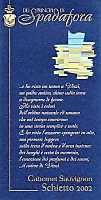
|
|
Schietto Cabernet Sauvignon 2002 |
|
| Spadafora (Sicily, Italy) | |
| Grapes: Cabernet Sauvignon | |
| Price: € 20.15 | Score: |
| This wine shows an intense ruby red color and nuances of ruby red, little transparency. The nose reveals intense, clean, pleasing and refined aromas which start with hints of black cherry, plum and black currant followed by aromas of blueberry, violet, licorice, vanilla, tobacco, cocoa, eucalyptus and mace. The mouth has good correspondence to the nose, a tannic attack and pleasing roundness, however balanced by alcohol, full body, intense flavors, good tannins. The finish is persistent with flavors of black cherry, plum and black currant. A well made wine. This Cabernet Sauvignon ages for 12 months in barrique followed by 6 months of aging in bottle. | |
| Food Match: Game, Roasted meat, Stewed and braised meat, Hard cheese | |
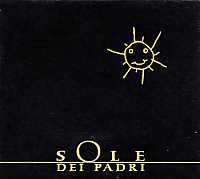
|
|
Sole dei Padri 2002 |
|
| Spadafora (Sicily, Italy) | |
| Grapes: Syrah | |
| Price: € 42.00 | Score: |
| This Syrah shows an intense ruby red color and nuances of garnet red, little transparency. The nose reveals intense, clean, pleasing, refined and elegant which start with aromas of black cherry, plum and blueberry followed by aromas of black currant, blackberry, violet, vanilla, licorice, black pepper, cocoa, eucalyptus and menthol. The mouth has correspondence to the nose, a tannic attack and however balanced by alcohol, full body, pleasing roundness, intense flavors, good tannins. The finish is persistent with flavors of black cherry, plum and blueberry. A well made wine. Sole dei Padri ages for 12 months in barrique followed by 10 months of aging in bottle. | |
| Food Match: Game, Roasted meat, Stewed and braised meat, Hard cheese | |
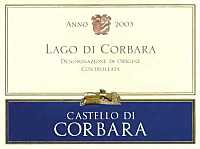
|
|
Lago di Corbara 2003 |
|
| Castello di Corbara (Umbria, Italy) | |
| Grapes: Sangiovese (50%), Cabernet Sauvignon (25%), Merlot (25%) | |
| Price: € 14.00 | Score: |
| The wine shows an intense ruby red color and nuances of ruby red, little transparency. The nose reveals intense, clean, pleasing and refined aromas that start with hints of black cherry, blackberry and plum followed by aromas of black currant, blueberry, violet, vanilla, , licorice, tobacco, cinnamon and menthol. The mouth has good correspondence to the nose, a tannic attack and however balanced by alcohol, good body, intense flavors, agreeable. The finish is persistent with flavors of black cherry and plum. A well made wine. This wine ages for 12 months in barrique and cask followed by 5-6 months of aging in bottle. | |
| Food Match: Roasted meat, Braised and stewed meat, Hard cheese | |
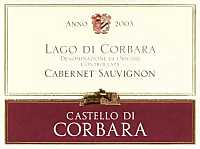
|
|
Lago di Corbara Cabernet Sauvignon 2003 |
|
| Castello di Corbara (Umbria, Italy) | |
| Grapes: Cabernet Sauvignon | |
| Price: € 16.00 | Score: |
| This Cabernet Sauvignon shows an intense ruby red color and nuances of ruby red, little transparency. The nose reveals intense, clean, pleasing and refined aromas which start with hints of black cherry, black currant and plum followed by aromas of blueberry, vanilla, bell pepper, cyclamen, licorice, tobacco, cinnamon, eucalyptus and pink pepper. The mouth has good correspondence to the nose, a tannic attack and however balanced by alcohol, good body, intense flavors, agreeable. The finish is persistent with flavors of black cherry, plum and black currant. A well made wine. This wine ages for 12 months in barrique followed by 5-6 months of aging in bottle. | |
| Food Match: Roasted meat, Stewed and braised meat, Hard cheese | |
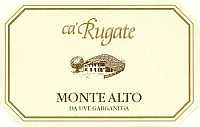
|
|
Soave Classico Monte Alto 2003 |
|
| Ca' Rugate (Veneto, Italy) | |
| Grapes: Garganega | |
| Price: € 11.50 | Score: |
| This Soave shows a brilliant straw yellow color and nuances of straw yellow, very transparent. The nose reveals intense, clean, pleasing and elegant aromas which start with hints of pear, plum and almond followed by aromas of chamomile, pineapple, hawthorn, peach, broom, apple and hints of vanilla and mineral. The mouth has good correspondence to the nose, a crisp attack and pleasing smoothness, however well balanced by alcohol, good body, intense flavors. The finish is persistent with flavors of pear, plum and almond. A well made wine. Monte Alto ages for 6-8 months in barrique. | |
| Food Match: Pasta with mushrooms, Mushrooms soup, Roasted and stewed meat, Roasted white meat | |
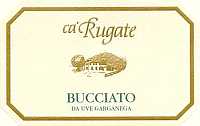
|
|
Bucciato 2003 |
|
| Ca' Rugate (Veneto, Italy) | |
| Grapes: Garganega | |
| Price: € 8.00 - 50cl | Score: |
| This wine shows an intense golden yellow color and nuances of golden yellow, very transparent. The nose reveals intense, clean, pleasing, refined and elegant aromas which start with hints of quince, plum and medlar followed by aromas of chamomile, honey, almond, hawthorn, hazelnut, pear and peach. The mouth has good correspondence to the nose, a crisp attack and pleasing smoothness, however well balanced by alcohol, good body, intense flavors, agreeable. The finish is persistent with flavors of plum, quince and almond. A well made wine. Bucciato ferments with its skins and ages in steel tanks. | |
| Food Match: Roasted fish, Stewed fish with mushrooms, Roasted white meat | |
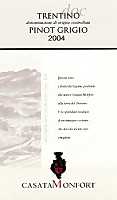
|
|
Trentino Pinot Grigio 2004 |
|
| Casata Monfort (Trentino, Italy) | |
| Grapes: Pinot Gris | |
| Price: € 7.20 | Score: |
| The wine shows a brilliant greenish yellow color and nuances of greenish yellow, very transparent. The nose reveals intense, clean, pleasing and refined aromas which start with hints of pear and apple followed by aromas of hawthorn, jasmine, broom, peach and plum. The mouth has good correspondence to the nose, a crisp attack and however balanced by alcohol, good body, intense flavors. The finish is persistent with flavors of pear, apple and peach. This Pinot Gris ages in steel tanks for 5 months followed by 2 months of aging in bottle. | |
| Food Match: Pasta and risotto with vegetables and crustaceans, Fried fish | |
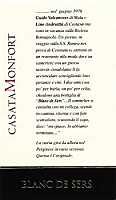
|
|
Blanc de Sers 2004 |
|
| Casata Monfort (Trentino, Italy) | |
| Grapes: Nosiola (20%), Chardonnay (15%), Muscat Blanc (15%), Wanderbara (25%), Veltliner Rosato (20%), Vernaza (5%) | |
| Price: € 7.05 | Score: |
| This wine shows a brilliant greenish yellow color and nuances of greenish yellow, very transparent. The nose reveals intense, clean, pleasing and refined aromas which start with hints of grape, peach and elder followed by aromas of hawthorn, broom, banana, pear and apple. The mouth has good correspondence to the nose, a crisp attack and however balanced by alcohol, good body, intense flavors, agreeable. The finish is persistent with flavors of peach, pear and banana. Blanc de Sers ages for 12 months in steel tanks followed by 3 months of aging in bottle. | |
| Food Match: Vegetable and mushroom soups, Pasta and risotto with crustaceans and fish | |
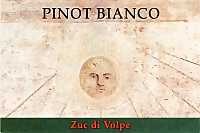
|
|
Colli Orientali del Friuli Pinot Bianco Zuc di Volpe 2004 |
|
| Volpe Pasini (Friuli Venezia Giulia, Italy) | |
| Grapes: Pinot Blanc | |
| Price: € 15.00 | Score: |
| The wine shows a pale straw yellow color and nuances of greenish yellow, very transparent. The nose denotes intense, clean, pleasing, refined and elegant aromas which start with hints of peach, pear and lemon followed by aromas of apple, pineapple, gooseberry, white rose, acacia, broom, hazelnut and vanilla. The mouth has good correspondence to the nose, a crisp attack and pleasing smoothness, however well balanced by alcohol, good body, intense flavors. The finish is persistent with flavors of lemon, pear and peach. A well made wine. Part of this Pinot Blanc ages in steel tanks and the other part in barrique. | |
| Food Match: Pasta and risotto with fish and crustaceans, Vegetables pudding, Sauteed crustaceans | |

|
|
Focus Merlot Zuc di Volpe 2003 |
|
| Volpe Pasini (Friuli Venezia Giulia, Italy) | |
| Grapes: Merlot | |
| Price: € 20.00 | Score: |
| The wine shows a deep ruby red color and nuances of ruby red, little transparency. The nose reveals intense, clean, pleasing, refined and elegant aromas which start with hints of black currant, plum and black cherry followed by aromas of blueberry, violet, vanilla, licorice, tobacco, cocoa, cinnamon, mace, menthol and pink pepper. The mouth has good correspondence to the nose, a tannic attack and however well balanced by alcohol, good body, intense flavors, pleasing smoothness. The finish is very persistent with long flavors of black currant, plum and black cherry. A well made wine. Focus Merlot ages for 12 months in barrique followed by 8 months of aging in bottle. | |
| Food Match: Roasted meat, Braised and stewed meat, Hard cheese | |
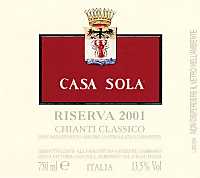
|
|
Chianti Classico Riserva Casa Sola 2001 |
|
| Fattoria Casa Sola (Tuscany, Italy) | |
| Grapes: Sangiovese (90%), Cabernet Sauvignon (7%), Merlot (3%) | |
| Price: € 18.00 | Score: |
| This reserve of Chianti Classico shows an intense ruby red color and nuances of garnet red, little transparency. The nose reveals intense, clean, pleasing and refined aromas that start with hints of black cherry and plum followed by aromas of blueberry, violet, licorice, carob and vanilla. The mouth has good correspondence to the nose, a slightly tannic attack and appreciable smoothness, however balanced by alcohol, good body, intense flavors. The finish is persistent with flavors of black cherry and plum. This wine ages for 18 months in cask followed by at least 6 months of aging in bottle. | |
| Food Match: Roasted meat, Broiled meat, Stewed meat, Hard cheese | |
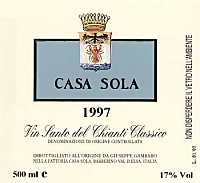
|
|
Vin Santo del Chianti Classico 1997 |
|
| Fattoria Casa Sola (Tuscany, Italy) | |
| Grapes: Trebbiano Toscano, Malvasia del Chianti | |
| Price: € 10.00 - 500ml | Score: |
| The wine shows an intense amber yellow color and nuances of amber yellow, transparent. The nose reveals intense, clean, pleasing and refined aromas which start with hints of raisin, fig jam and almond followed by aromas of peach jam, apricot jam, caramel, date, honey, vanilla and hints of rosemary. The mouth has good correspondence to the nose, a sweet and smooth attack, however balanced by alcohol, full body, intense flavors, agreeable. The finish is persistent with flavors of fig jam, almond and raisin. This Vin Santo ages for 5 years in small barrels. | |
| Food Match: Hard and piquant cheese, Almond and dried fruit tarts | |
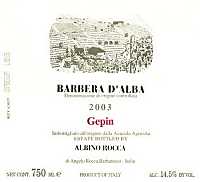
|
|
Barbera d'Alba Gepin 2003 |
|
| Albino Rocca (Piedmont, Italy) | |
| Grapes: Barbera | |
| Price: € 14.00 | Score: |
| The wine shows an intense ruby red color and nuances of ruby red, little transparency. The nose reveals intense, clean, pleasing and refined aromas which start with hints of black cherry and blueberry followed by aromas of raspberry, plum, violet, vanilla, carob, menthol and hints of black pepper. The mouth has good correspondence to the nose, a tannic attack and pleasing crispness, however balanced by alcohol, good body, intense flavors. The finish is persistent with flavors of black cherry and plum. This Barbera ages for 14 months in cask. | |
| Food Match: Roasted meat, Stewed and braised meat with mushrooms, Hard cheese | |
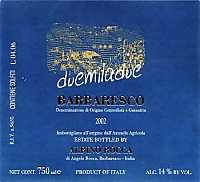
|
|
Barbaresco 2002 |
|
| Albino Rocca (Piedmont, Italy) | |
| Grapes: Nebbiolo | |
| Price: € 22.00 | Score: |
| This Barbaresco shows an intense ruby red color and nuances of ruby red, little transparency. The nose denotes intense, clean, pleasing and refined aromas which start with hints of black cherry, plum and blackberry followed by aromas of blueberry, violet, cinnamon, licorice, tobacco, carob, vanilla and black pepper. The mouth has good correspondence to the nose, a tannic attack and however balanced by alcohol, pleasing crispness, full body, intense flavors. The finish is persistent with flavors of black cherry and plum. This Barbaresco ages for 18 months in cask. | |
| Food Match: Game, Roasted meat, Braised and stewed meat, Hard cheese | |
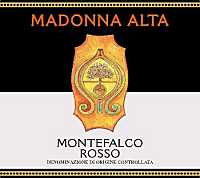
|
|
Montefalco Rosso 2003 |
|
| Madonna Alta (Umbria, Italy) | |
| Grapes: Sangiovese (65%), Merlot (20%), Sagrantino (15%) | |
| Price: € 12.00 | Score: |
| The wine shows an intense ruby red color and nuances of ruby red, little transparency. The nose denotes intense, clean, pleasing and refined aromas which start with hints of black cherry, blackberry and plum followed by aromas of blueberry, violet, carob and vanilla. The mouth has good correspondence to the nose, a slightly tannic attack and however balanced by alcohol, good body, intense flavors, agreeable. The finish is persistent with flavors of black cherry and plum. This Montefalco Rosso ages for 12 months in barrique. | |
| Food Match: Roasted meat, Broiled beat, Stewed meat with mushrooms | |
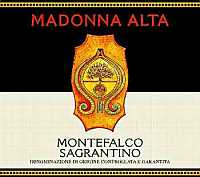
|
|
Montefalco Sagrantino 2002 |
|
| Madonna Alta (Umbria, Italy) | |
| Grapes: Sagrantino | |
| Price: € 20.00 | Score: |
| The wine shows an intense ruby red color and nuances of ruby red, little transparency. The nose denotes intense, clean, pleasing and refined aromas of black cherry, blackberry and plum followed by aromas of blueberry, violet, licorice, tobacco, cinnamon, cocoa, vanilla and mace. The mouth has good correspondence to the nose, a tannic attack and however balanced by alcohol, full body, intense flavors. The finish is persistent with flavors of blackberry, black cherry and plum. A well made wine. This Sagrantino di Montefalco ages for 18 months in barrique and cask. | |
| Food Match: Game, Roasted meat, Braised and stewed meat, Hard cheese | |
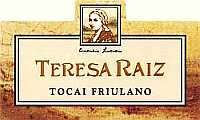
|
|
Colli Orientali del Friuli Tocai Friulano 2004 |
|
| Teresa Raiz (Friuli Venezia Giulia, Italy) | |
| Grapes: Tocai Friulano | |
| Price: € 8.38 | Score: |
| This Tocai Friulano shows a brilliant greenish yellow color and nuances of greenish yellow, very transparent. The nose reveals intense, clean, pleasing, pleasing and refined aromas which start with hints of pear and plum followed by aromas of almond, pineapple, hawthorn, medlar, apple and elder. The mouth has good correspondence to the nose, a crisp attack and however balanced by alcohol, good body, intense flavors. The finish is persistent with flavors of pear, plum and almond. This wine ages with at least 6 months in steel tanks and for at least one month in bottle. | |
| Food Match: Fried fish, Pasta and risotto with fish, Roasted fish, Eggs | |
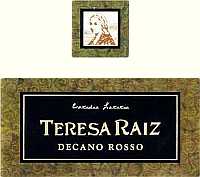
|
|
Colli Orientali del Friuli Rosso Decano 2001 |
|
| Teresa Raiz (Friuli Venezia Giulia, Italy) | |
| Grapes: Cabernet Sauvignon (40%), Cabernet Franc (40%), Merlot (20%) | |
| Price: € 17.42 | Score: |
| The wine shows an intense ruby red color and nuances of ruby red, little transparency. The nose reveals intense, clean, pleasing and refined aromas that start with hints of black cherry, plum and black currant followed by aromas of blueberry, vanilla, licorice, tobacco, bell pepper, eucalyptus, cocoa, black pepper and hints of coffee. The mouth has good correspondence to the nose, a tannic attack and however balanced by alcohol, full body, intense flavors. The finish is persistent with flavors of black cherry, plum and black currant. A well made wine. Decano Rosso ages for 12 months in barrique followed by 6 months of aging in bottle. | |
| Food Match: Roasted meat, Braised and stewed meat, Hard cheese | |
|
||||||||
|
DiWineTaste Polls
|
| |||||||
Privacy Policy | |||||||


| Copyright © 2002-2024 Antonello Biancalana, DiWineTaste - All rights reserved |
| All rights reserved under international copyright conventions. No part of this publication and of this WEB site may be
reproduced or utilized in any form or by any means, electronic or mechanical, without permission in writing from DiWineTaste. |